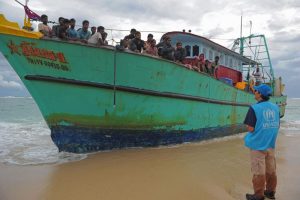When European leaders talk of establishing “disembarkation platforms” for migrants in the Middle East and Africa, they are hoping to find an “Australian solution” to a hot-button issue.
Here’s why. Australia’s policies towards unwanted migrants are tough, deeply controversial — and they have worked.
Australia has all but become a no-go area for the uninvited. Even people who genuinely seek asylum because of a credible fear of persecution in their home country would rather not make for Australia.
That is success of a sort. Australia may be unable to lay claim to a sensitive moral compass, having been called out by the UN Special Rapporteur on Torture for breaching the Convention on Torture, but Australian authorities seem to feel blessedly free from the care of thousands of unwanted people. They are proud their country is seen to have one of the Western world’s most hard-bitten, results-oriented approaches to migration.
What is it? Here goes.
In 2013, Australian Prime Minister Kevin Rudd declared that any asylum seeker who arrived by boat “will have no chance of being settled in Australia as a refugee.” It was both a promise and a threat. Operation Sovereign Borders was begun and the Australian military intercepted migrant boats and either towed them to Indonesia or extracted the passengers and returned them in lifeboats from wherever they had set off.
The results are obvious. From a 2013 peak of 20,587 people arriving in Australia by sea, Canberra boasts “it has been almost three years since the last people smuggling boat made it to Australia.” Operation Sovereign Borders’ log of its work offers the following as its most recent engagement: “In December 2017, Australian authorities intercepted a Sri Lankan people smuggling boat attempting to reach Australia illegally. All 29 people on board were returned to Sri Lanka.”
These are small numbers and they attest to the success of Australia’s policy, something Hungarian Foreign Minister Peter Szijjarto recently commended on in a speech in London.
Australia added another extraordinary twist to the long and difficult process of applying for asylum. From 2013, it sent all asylum-hopefuls to holding camps in Papua, New Guinea and Nauru. Successful applicants could seek residency in Papua New Guinea but never set foot on Australian soil.
It’s worth noting that Australia’s 2013 policy came after 20 years of a steadily hardening position on migration. In 1992, it adopted a mandatory detention policy for anyone who entered the country without a valid visa. (This is akin to what Donald Trump’s America has been doing with its zero-tolerance policy towards uninvited migrants.)
In 2001, Australia tried the Pacific Solution, which meant intercepting migrant boats and holding the passengers on Nauru and Papua New Guinea for processing. This ended after six years but was reborn in 2013 as a twin-pronged, sharper-edged effort that refused to allow asylum-seekers (successful or not) on Australian territory.
Nauru and Papua New Guinea were a key part of the plan, though the latter’s processing centre closed eight months ago over a wrangle with the Papua New Guinea Supreme Court’s interpretation of asylum-seekers’ human rights.
The Australian template is clearly delineated and it’s worth asking if this is what European leaders mean by “disembarkation platforms” and whether Tunisia, Morocco, Algeria, Libya and Egypt should play the role of Papua New Guinea and Nauru and prevent asylum-seekers from setting foot on European soil.
Thus far, there has been little sign that Middle Eastern and North African countries will agree to create facilities that would really serve as prisons for the long-term detention of migrants. One by one, North African countries have said they will not play along with a scheme that seems ethically dubious and logistically difficult.
They are right on both counts. What works for Australia in the Pacific may not work for the Europeans in the Mediterranean. For one, the trip across the waters from Libya or Tunisia is shorter than from Indonesia to Australia. Second, it may be more difficult to find a receptive partner in North Africa than in the Pacific.
Ali Abdel A’al, speaker of the Egyptian parliament, told Germany’s Welt am Sonntag newspaper: “EU reception facilities for migrants in Egypt would violate the laws and constitution of our country.” Libyan Deputy Prime Minister Ahmed Maiteeq had said much the same after his Italian counterpart, far-right League leader Matteo Salvini, made the request for “reception centres” while visiting Tripoli.
That said, there is always a chance that one of Libya’s many competing power centres may accept oodles of European cash in exchange for the distinction of setting up a “disembarkation platform.” That’s how the Australian solution would be replicated in Europe.


